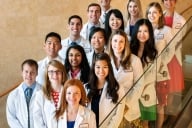You have /5 articles left.
Sign up for a free account or log in.

ISTOCK.COM/SDI Productions
Clinical training for students in health-care fields effectively came to a halt when the coronavirus pandemic was declared in March. Colleges and the hospitals and other clinical sites with which they partner canceled clinical placements to protect students and patients from infection and preserve scarce supplies of personal protective equipment (PPE) for essential workers. Colleges turned to alternative means to give students clinical training using telehealth and simulations, even while health-care educators acknowledged there was no substitute for in-person patient contact.
Three months later, as more and more states emerge from lockdowns prompted by the public health emergency, students in health-care fields are starting to resume in-person clinical training. The process of returning is not simple or straightforward, however, and it varies across institutions and health-care fields.
Academic programs have to consider requirements from accrediting agencies and state licensing bodies, as well as the needs of their clinical partners and student and patient safety, in opening up clinical education opportunities. In many cases, there are new constraints on capacity as clinical sites adopt new protocols and enforce social distancing imperatives. Furloughs and layoffs of health-care professionals due to declines in elective procedures have also affected the availability of clinical opportunities: fewer providers mean fewer student placements. And in some cases clinical providers are newly asking students -- or their schools -- to provide the students' PPE, adding yet another complication and expense for colleges resuming clinical education.
“The practitioners need to figure out how they’re going to make the students fit in,” said Julie O'Sullivan Maillet, chair of the Association of Schools Advancing Health Professions’ clinical education task force and a professor of nutritional sciences at Rutgers University in New Jersey. “There are issues we’ve always had with students of where do we put them, how do we be less overwhelming to patients. Now we have to think about are we putting them at risk, do we have enough PPE, do we have enough space? It’s just a different world.”
Donna Meyer, chief executive officer for the Organization for Associate Degree Nursing, said that while nursing students are starting to return to clinical placements, there is not one set standard.
“It is different from health-care facility to health-care facility. Even within a city or a county, some of the hospitals have different policies,” she said.
Meyer said many clinical sites are consistent across the board about restricting nursing students from working with patients with COVID-19 or from working in either emergency rooms or intensive-care units. Long-term-care facilities, whose residents have been hard hit by the pandemic, are also largely off-limits.
Cleveland Clinic began accepting students again on June 1 with new protocols in place, including new screening procedures. Mari Knettle, who coordinates student placements in 60 health-care fields other than medicine and nursing as director of Cleveland Clinic’s Center for Health Sciences Education, said students must answer screening questions about their travel, potential symptoms and exposure to the coronavirus before they are allowed back. Students are also expected to abide by policies similar to those in place for Cleveland Clinic’s caregivers, including a policy on wearing face masks.
Knettle said Cleveland Clinic has had to make decisions on whether to bring students back department by department. Not every area of health care has restarted clinical training opportunities.
“It’s a decision that’s made on a case-by-case basis with the safety of everybody involved in the forefront,” Knettle said. For those health-care departments that haven’t reopened clinical opportunities, she said they’re considering factors including different patterns of care.
"We’re looking at social distancing and capacity to have individual bodies in a certain space," she said. "We’re looking at providers who are learning new ways of providing care themselves and may not be ready to also be mentoring somebody who is learning how to provide care at the same time that they’re learning something that’s very different from what they’re used to doing. We also had some changes in the care that was provided in terms of volumes, so we’re looking at new schedules, new caseloads where we can’t predict the experience that a student would have."
Things are ramping back up, Knettle said. “But everything’s not back to normal, so when the care’s not normal, the education in turn can’t be normal.”
Continuing the Pipeline
Even as clinical placements start to reopen, health-care educators remain concerned about the potential that they could close again if there is a surge in COVID-19 cases. More than half of U.S. states are currently reporting increased numbers of cases.
“So far our schools have said they do have capacity,” said Alison J. Whelan, chief medical education officer for the Association of American Medical Colleges. However, “I think if we have another surge and had to close some things down, it could become a real concern.”
Whelan said surveys of medical schools done by AAMC found that, as of June 17, 30 percent have sent students back to clinical settings for their core clerkship rotations, and 47 percent have sent back students in their fourth and final year who are completing clinical electives. About three-quarters anticipate that their advanced third- and fourth-year students will resume direct patient-care activities by the end of July.
“We’re balancing the need for the students to continue their education and safety: it’s public health safety as much as it is student safety,” Whelan said. “The on-time graduation of the vast majority for our medical students is needed to continue the pipeline of the physician workforce.”
Deborah Trautman, president and chief executive officer of the American Association of Colleges of Nursing, said most deans she has spoken to are looking to resume clinical education in the fall, while some are starting up this summer.
"Depending on the area, there will be in some cases a gradual ramp-up similar to what is happening in the health-care delivery system," she said. "For example, outpatient imagery is resuming, but at a much lower volume. There will still be experiences, but it will be important to match the number of students that a site can accommodate based on both the patient volume as well as other issues that they need to consider."
Trautman said availability of PPE remains "the No. 1 factor that will be restrictive." She stressed the importance of strong partnerships between nursing programs and health-care facilities.
"Even before the virus, clinical placements in some places were more challenging, and what has really helped with addressing the challenges of finding the appropriate clinical placements in nursing is strong academic practice partnerships when we have our academic and practice leaders coming together. That really helps us identify where these opportunities are for students. In the places where there are strong academic practice partnerships, we are hearing that they’re facing less challenges."
Beyond Nursing and Medicine
The pandemic has disrupted clinical placements not just in nursing and medicine, but in a wide variety of health-care fields.
Peter Hu, president of the National Accrediting Agency for Clinical Laboratory Science and interim dean of the School of Health Professions at the University of Texas MD Anderson Cancer Center, said students in clinical laboratory science programs have started to resume clinical placements, with new PPE and sterilization requirements and new protocols in place for self-monitoring, social distancing and reporting potential exposures. In most programs, Hu said, students can make their own choices about whether they will handle laboratory samples from COVID-positive patients.
Hu estimated that about half of clinical laboratory sciences programs have returned to clinical sites.
“I’m cautiously optimistic that if we don’t have too big of an increase in spikes that we can slowly move forward with the incorporation of more sites, but a lot of the places still haven’t decided yet if they want to open up fully for student rotations -- and rightfully so. There are so many unknowns out there.”
Hu added that labs in some cases are not allowing laboratory scientists to intermingle across different buildings or shifts.
“The sites, they’re still a business, so they have to address their business needs first, and if there’s room available after that then they can allow students to go in with the social distancing rules. Depending on the size, it may limit the number of students who can rotate at any given time,” he said.
The American Council for Academic Physical Therapy has issued guidance for resuming clinical education, including strategies for maximizing capacity by reassessing the curriculum to ensure accreditation standards are met in an efficient manner, using “innovative” scheduling and prioritization for clinical education placements, and sharing resources across academic programs and clinical sites.
Anne Reicherter, the director of academic and clinical affairs at the American Physical Therapy Association, said while some clinical sites are reopening, “I still think it’s pretty slow.” Capacity in terms of hospital-based placements was an issue even before the pandemic, because rehabilitation patients tend to have short hospital stays, she said. And outpatient clinics have been cautious about taking students back.
“They don’t want students there if there’s anything that’s going to disrupt their business; they’re very cautious in returning anything new back into that system,” Reicherter said.
Reicherter noted that many clinics have also ramped up their telehealth and telerehabilitation offerings, giving students alternative opportunities to gain clinical experience.
Audiology and speech language pathology programs also are increasingly using telehealth to help students satisfy clinical requirements. Judy Blackburn, associate director for academic affairs and research education at the American Speech-Language-Hearing Association, said some externship placements are not accepting students at all, while others are willing to accept students with PPE and social distancing requirements in place.
“Before COVID-19, most programs provided the majority of their clinical training through in-person settings, both on-site in university clinics and off-site for clinical externships,” Blackburn said in an email. “At this time, the majority of clinical programs are using a combination of service provision formats, including in-person services, telepractice options, and clinical simulations. Many programs report that graduate students were able to obtain all required clinical hours by the end of the spring semester, though there is ongoing concern about finding sufficient placements for the next cohorts of students in the programs.”




